Apocalyptic (in 1 & 2 Thessalonians)
![]() Home A B C D E F G H I J K L M N O P Q R S T U V W X Y Z Abbreviations Glossary
Home A B C D E F G H I J K L M N O P Q R S T U V W X Y Z Abbreviations Glossary
The term apocalyptic derives from the Greek word apokalupsis, meaning revelation or unveiling. It describes both a genre of literature and a theological mind-set. Even though Paul’s letters cannot be described as apocalyptic literature, like Daniel in the OT or the Revelation of John in the NT, Paul’s theology is shaped by Jewish apocalypticism.
Apocalyptic writings within the Jewish community often surfaced during times of national crisis, such as the Maccabean War (167–164 B.C.), the Roman conquest of Judea (63 B.C.), the Jewish War with Rome (A.D. 66–70), and experiences of persecution under emperor Domitian, A.D. 81–96. The theological themes featured in these writings also influenced other writings, including Paul’s letters.
One of the characteristic features of apocalyptic thought is the dualistic doctrine of two ages: this present age is passing away, and the age to come is about to begin. Such dualism also manifests itself both in the way apocalyptic writings depict the inner personal struggles between good and evil and in their portrayal of the cosmic tug-of-war between God and Satan. However, writers of apocalyptic envision that in the end God and good will triumph over Satan and evil. In fact, history moves relentlessly toward the time when God will win the victory. The faithful therefore just need to be steadfast until the end. Through a future cataclysmic act of divine intervention, God will judge the wicked and vindicate the faithful.
We can illustrate this from a Jewish apocalypse roughly contemporary with the writings of the NT. In 2 Esdras, the divine messenger declares:
- This present world is not the end; the full glory does not remain in it; therefore those who were strong prayed for the weak. But the day of judgment will be the end of this age and the beginning of the immortal age to come, in which corruption has passed away, sinful indulgence has come to an end, unbelief has been cut off, and righteousness has increased and truth has appeared. (2 Esd. 7:112–114, Apocrypha)
The primary intention of 2 Esdras is to reassure the Jewish people, still reeling from the fall of Jerusalem and the destruction of the temple at the end of the Jewish War (A.D. 66–70). Despite present indications to the contrary, God is still in control, and justice will ultimately prevail.
In his letter to the Galatians, Paul describes his life-transforming experience on the way to Damascus as “a revelation (apokalupsis) of Jesus Christ” (Gal. 1:12; cf. 1:16). The opening greeting of the same letter depicts the impact of the death of Jesus Christ in apocalyptic terms: “who gave himself for our sins to set us free from the present evil age” (Gal. 1:4). On the basis of these and related texts, there is a growing consensus that Paul’s theology derives to a significant extent from Jewish apocalyptic. NT scholar J. Christiaan Beker, who has helped to shape this consensus, can be cited to illustrate these conclusions concerning Paul’s theology. In a book entitled The Triumph of God, Beker describes the significance of apocalyptic for Paul under two points:
- The significance of apocalyptic for Paul may be outlined as follows:
- 1. The enduring center of Paul’s gospel is his conviction that Christ’s death and resurrection have opened up a new future for the world. This future will reach its climax when the reign and triumph of God are made manifest and the whole created order attains its wonderful perfection according to God’s promises to Israel.
- 2. The apocalyptic framework of the gospel also corresponds to the manner in which Paul proclaims it. The gospel concerning the future reign of God is brought to expression in such a way that, analogous to the incarnation of God in Christ, it embodies itself in the concrete and varied circumstances of human life. In this way Paul enables his churches to discern already in the present time signs of God’s future glory. Moreover, Paul’s churches are empowered by God to participate in redemptive praxis in the world, which aims at preparing the whole creation for its future glory. (Beker, 1990:20)
According to Jewett, in Thessalonica Paul’s apocalyptic message was interpreted by some radicals within the Christian community along the lines of the cult of the Cabiri. Within this particular mystery cult, the redeemer figure was expected to return to defend the rights of laborers and establish a realm of bliss and freedom (Jewett, 1986:176–178). If this reconstruction is correct, the millenarian radicalism of the unruly (2 Thess. 2:2–3; 3:6–13), though rooted in the apocalyptic expectation of the triumphant return of Christ, was significantly shaped by the mystery religions as well.
| —Jacob W. Elias |
